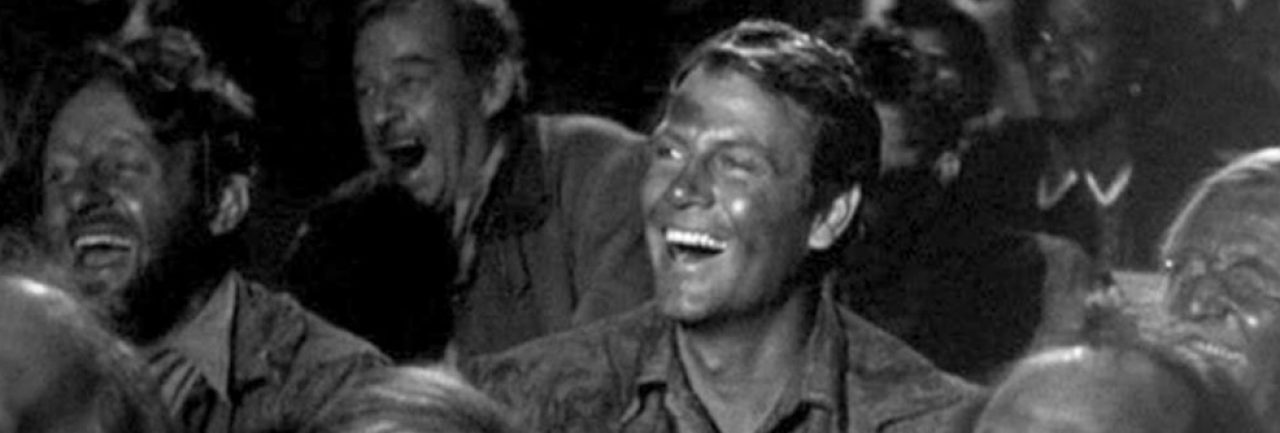
Brian De Palma’s Blow Out (1981) begins, appropriately, with the sound of heavy breathing. We see the outside of what turns out to be a sorority house. A security guard lingers in front of a window, watching as two very scantily clad sorority sisters dance to loud rock music. All of a sudden a knife appears in our frame a vision, and–from the point of view of us, the audience–the guard is stabbed in the back. The killer moves over to the next room, whose occupant is having sex with a guy. She sees the slasher and yells out. But it’s too late–he’s already in the house. As he strolls the halls he observes more young women wearing very little clothing and gazing at one with no clothing, in a shower stall. Out comes the knife, and before we can say Psycho, she sees him and screams…
And we cut to John Travolta, a cigarette in his mouth, giggling. “God, that scream is terrible,” he says. We’re in a screening room where Travolta’s character–sound designer Jack Terry–and the director have just watched the same footage we have.
After some back and forth about the scream, the director asks how long the two of them have worked together. Jack: “Well, let’s see. I met you on Blood Bath, right, and then we did Blood Bath 2. And then we did Bad Day at Blood Beach, and then we did Bordello of Blood. That brings us up to date, Coed Frenzy.”
Coed Frenzy is specifically a … takeoff on? homage to? … Bob Clark’s Black Christmas (1974), which shares the killer-in-the-sorority-house setting and is sometimes credited (?) with being the first slasher film. Blogger and author Dan Hassler-Forest makes a distinction between Black Christmas and John Carpenter’s much more successful Halloween, which came out four years later:
Halloween and its many, many imitators tend to transform the intended victims into objects for us to stare at as they are being stalked, pursued, and threatened by the killer, thereby aligning us with the aggressor’s point of view. The implicit misogyny of the resulting formula was parodied most effectively by Brian de Palma in the opening scene of his masterpiece Blow Out, where every sexist cliché in the genre book is thrown at us. As early as 1981, it was apparently obvious to someone as astute as De Palma that slasher movies were all about ogling women as fetishized sex objects before taking sadistic pleasure in seeing them suffer.
I’m not sure if I would be so quick to credit De Palma with astuteness and parody. Rather, he appears to be fetishizing (or at least directing his gaze at) the women, and then taking sadistic pleasure in their fate. The sleazy director tells Travolta, “I didn’t hire that girl for her scream, I hired her for her tits.” To me, that about sums up De Palma’s actress-casting philosophy.
Travolta goes out to Fairmount Park to record some sound effects for Coed Frenzy. (The thing I like best about this movie are the many Philadelphia locations. I moved to town the year after Blow Out was released, and the film is an archive of many things that have changed, like the Reading Terminal, RIP, and a few that have stayed much the same, like the Reading Terminal Market.) While there he happens to record the sound of a car plummeting off the bridge, a car that happens to have in it a politician and a woman not his wife. Shades of Chappaquiddick.
Listening to the recording, Jack is convinced that it contains evidence of nefarious doings, and he becomes obsessed with it. Shades of Hitchcock’s Rear Window, Antonioni’s similarly titled Blow-Up, and Coppola’s The Conversation. There is some interesting exploration of voyeurism and ’70s-style conspiracy, and some typically well-crafted De Palma set pieces, but the film left a bad taste in my mouth. The repeated violence against women came off as exploitative (in a bad way) and, to use Hassler-Forest’s word again, sadistic.
Back to the subject of this blog, Dennis Franz plays a sleazy opportunist in Blow Out, as only Dennis Franz can. At one point he’s in a cheap motel room, and the TV is on, as TVs in cheap motel rooms always are. IMDB tells me that the movie he’s watching is Brian De Palma’s first film, Murder à la Mod (1968), which failed so badly that for years it was believed to be lost, and no one missed it. The plot, according to an IMDB contributor:
Naive young lady Karen wants to help her struggling amateur filmmaker boyfriend Christopher raise enough money so he can divorce his wife. Meanwhile, jolly psycho prankster Otto stalks the building where Christopher is shooting a low-grade adult movie in order to keep himself afloat.
From the get-go, apparently, De Palma was De Palma.
